Abstract
This study focuses on numerically addressing the time fractional Cattaneo equation involving Caputo–Fabrizio derivative using spline-based numerical techniques. The splines used are the cubic B-splines, trigonometric cubic B-splines and extended cubic B-splines. The space derivative is approximated using B-splines basis functions, Caputo–Fabrizio derivative is discretized, using a finite difference approach. The techniques are also put through a stability analysis to verify that the errors do not pile up. The proposed scheme’s convergence analysis is also explored. The key advantage of the schemes is that the approximation solution is produced as a smooth piecewise continuous function, allowing us to approximate a solution at any place in the domain of interest. A numerical study is performed using various splines, and the outcomes are compared to demonstrate the efficiency of the proposed schemes.
1. Introduction
The time fractional Cattaneo differential equation (TFCDE) under consideration is []
with initial conditions
and the boundary conditions,
where and are known functions. Moreover, is the Caputo-Fabrizio derivative given by
where and .
For mathematical modeling of real-world problems, fractional differential equations are often used. Scientists in a variety of fields are pushed to improve the interpretations of their findings by utilizing the fractional order derivatives, which are particularly useful. In mathematical modeling of many scientific situations, fractional order differential equations provide more accurate information than regular differential equations. Fractional derivatives are used to describe a variety of physical phenomena []. This is owing to the fact that fractional operators assess both global and local properties when analyzing system evolution. In addition, integer-order calculus can sometimes contradict the experimental results; therefore, non-integer order derivatives may be preferable []. It is difficult to determine the solution to fractional differential equations (FDEs). As a result, a numerical method must be used to obtain the solution to these partial differential equations. To tackle these problems numerically, many approaches have been developed and extended. The existence of solution of FDEs can be seen in []. Diethelm et al. presented the predictor-corrector method [] for the numerical solution of FDEs. Meerschaert and Tadjern [] developed a finite difference method for a fractional advection–dispersion equation. The homotopy analysis method [] for the fractional initial value problem was developed by Hashim et al. An eigenvector expansion method for motion containing fractional derivatives was presented by Suarez and Shokooh [].
When compared to the finite difference approach, other spectral methods, such as the operational matrix method, are particularly popular since they provide good accuracy and take less time to compute. This method works well with fractional ordinary differential equations (ODEs), fractional partial differential equations (PDEs), and variable order PDEs. Jafari et al. [] gave applications of Legendre wavelets in solving FDEs numerically. The Haar wavelet operational matrix of fractional order integration and its applications in solving fractional order differential equations can be seen in []. Chebyshev wavelets [] were used by Yuanlu for solving a nonlinear fractional order differential equation. Li and Sun [] developed a generalized block pulse operational matrix method for the solution of FDEs. Obidat [] used Legendre polynomials to approximate the solution of nonlinear FDEs. Genocchi polynomials [] were used by Araci to find numerical solutions of FDEs. Grbz and Sezer [] solved a class of initial and boundary value problems arising in science and engineering using Laguerre polynomials. Caputo and Fabrizio proposed one of the most recent fractional order derivatives. For more applications of this new derivative and the related work, the reader is referred to [,,,,,,,,,,,,,,].
In comparison to polynomials, the B-splines based collocation methods provide a good approximation rate, are computationally quick, numerically consistent, and have second-order continuity. To obtain numerical solutions to differential equations, multiple numerical approaches based on various forms of B-splines functions were recently utilized. Inspired by the popularity of spline approaches in finding numerical solutions of fractional partial differential equations, various splines-based numerical techniques have been developed for the numerical solution of the Cattaneo equation involving the Caputo–Fabrizio derivative. The main motivation behind this work is that to the authors’ knowledge, this equation has not been solved using the B-splines basis functions. In the current work, B-splines are used to approximate the space derivative, while the Caputo–Fabrizio derivative is approximated using finite differences. Moreover, the presented schemes are tested for stability and convergence analysis.
2. Numerical Schemes
In this section, the cubic B-splines, extended cubic B-splines and the trigonometric cubic B-splines are used to develop numerical techniques for the numerical solution of time fractional Cattaneo equation (TFCE) (1).
2.1. Numerical Scheme Based on Cubic B-Splines
Let and be the step length in space and time direction, respectively. Set , , where the positive integers, N and M, are used. The knots divide the solution domain equally into M equal subintervals , where . The approximate solution to the exact solution in the following form is acquired by our scheme for solving (1)
where are unknowns to be found, and [] are cubic B-splines basis (CuBS) functions given by
Here, and are survived due to the local support characteristic of the cubic B-splines so that the approximation at the grid point at the mth time level is given as
The time-dependent unknowns are found using the specified initial and boundary conditions as well as the collocation conditions on . As a result, the approximation and its required derivatives are
where Let be the collection of grid functions on a uniform mesh of the interval such that . A discrete approximation to at can be obtained as []
where,
and
Lemma 1
([]). From the definition of in (9), we have and ,
Lemma 2
([]). Suppose that , then
and
Now, we employ the Caputo–Fabrizio fractional derivative and CuBS to establish the numerical scheme for solving (1). Using CuBS and the approximation given in (8), we obtain
where . Thus, by ignoring and using the discretization , we have
Rearranging the above equation, we obtain
where and . Using the CuBS approximation (7) in (11), we obtain
where , , , and . In matrix notation, the above equation is expressed as
where the matrices , , , and G are
and
The above system gives equations in unknowns. For a unique solution, two additional linear equations are necessary. For this purpose, the boundary conditions are utilized as
By combining Equations (12) and (13), we have , a system of linear equations which can be solved uniquely.
2.2. Initial State
First of all, it is essential to find the initial vector to initiate the iteration procedure. This vector is obtained from initial conditions as
Thus, a system of linear equations results, and this system can be written in matrix notation as
where the matrices , and are
and
2.3. Numerical Scheme Based on Extended Cubic B-Splines
A cubic B-spline of degree four with a free parameter is called an extended cubic B-spline. This kind of cubic B-spline was introduced by Han and Liu in 2003. We follow the same notations for the time and space discretizations that we used before. The extended cubic B-spline (ECuBS) basis functions, are given by
where ∈. Here, and are survived due to local support characteristic of the cubic B-splines so that the approximation at the grid point at mth time level is given as
The time-dependent unknowns are found using the specified initial and boundary conditions as well as the collocation conditions on . As a result, the approximation and its required derivatives are
where and By following the same procedure as was done for cubic B-splines and using the ECuBS approximation given in (16), we obtain the following approximation to the solution of (1)
where, ,, and In matrix notation, the above Equation (17) is expressed as
where the matrices , and are
and
The above system gives equations in unknowns. For a unique solution, two additional linear equations are necessary. From the boundary conditions, we obtain the required equations as follows
By combining Equations (17) and (18), we have , a system of linear equations, which can be solved uniquely.
2.4. Numerical Scheme Based on Trigonometric Cubic B-Splines
We follow the same notations for the time and space discretizations used before. The trigonometric cubic B-spline (TCuBS) basis functions are given by []
where
Here, and are survived due to the local support characteristic of the trigonometric cubic B-splines so that the approximation at the grid point at mth time level is given as
The time-dependent unknowns are found using the specified initial and boundary conditions as well as the collocation conditions on . As a result, the approximation and its required derivatives are
where
By following the same procedure as was done for cubic B-splines and using the approximation (8) in (1), we obtain
where and . Using the CuTBS approximation given in (21), we obtain the following approximation to the solution of (1)
where , , , and . In matrix notation, (23) is expressed as
where the matrices , and are
and
The above system gives equations in unknowns. For a unique solution, two additional linear equations are necessary. From the boundary conditions, we obtained these equations as follows
By combining Equations (23) and (24), we have , a system of linear equations, which can be solved uniquely.
2.5. Stability Analysis
This section deals with stability analysis of the scheme based on cubic B-splines. The stability analysis of the schemes based on extended and cubic trigonometric B-splines can be carried out by a similar argument. We use the Fourier method to study the stability analysis of the scheme. Let be the perturbation vector of initial values and , be the approximate solution of the scheme (12). The error vector is defined as
where,
and
Define the grid functions as follows:
We can expand into Fourier series as
where,
Denoting
and using the Parseval’s equality,
we obtain
We can expand into Fourier series, and because the difference equations are linear, we can analyze the behavior of total error by tracking the behavior of an arbitrary nth component. Based on the above analysis, we can suppose that the solution of (11) has the following form
where . Substituting the above expression into (11), we obtain
Using the CuBS approximation given in (7) and Equation (26) in the above equation, we obtain
which, on further simplification, reduces to
where,
Definition 1
([,]). A scheme is called stable if there exists a positive number C, independent of j and m such that
where and are the exact solutions of the difference scheme and its perturbed equation, respectively.
Theorem 1.
Suppose that , are defined by (28), then for , we have
Proof.
We use the mathematical induction for proof. For , we have from (28),
Now, suppose that
Then, by using Lemmas 1 and 2, we obtain
This completes the proof. □
Theorem 2.
The scheme (12) is unconditionally stable for
Proof.
By using Theorem 1, Parseval’s equality and , we obtain
so that
which means that the scheme is unconditionally stable. □
3. Convergence Analysis
The convergence of the scheme based on cubic B-splines is presented in this section. The convergence analysis of the extended and cubic trigonometric B-splines based numerical scheme follows accordingly. Let , , and
From Equation (11) and and noting that , we have
Define the functions
and
We expand the above functions into Fourier series expansions as
where,
Applying Parseval’s equalities,
to the above expression, we have
Now, we suppose that
where Substituting relations (31) in Equation (29).
The above expression is further simplified as
Theorem 3.
Let be the solution of (32), then, there is a positive constant C such that
Proof.
We use the mathematical induction to prove this claim. For , we have from (32)
Assume that
Now by using the convergence of the series on the RHS of (30), we know that there exists a constant such that
From (32), we have
□
Theorem 4.
The scheme (12) is convergent, and the order of convergence is .
Proof.
By Theorem 3, Equation (30) and , we have
This completes the proof. □
4. Numerical Findings and Discussion
The efficiency and the validity of the suggested methodologies are confirmed in this part using various test problems by utilizing the and error norms. The numerical results obtained by the proposed schemes are compared. Mathematica 12 was used to obtain the numerical and graphical results.
Example 1.
Consider the time fractional Cattaneo equation,
with initial constraint,
and with boundary constraint,
The corresponding source term is
The analytic solution of the given problem is . The suggested schemes are implemented on the aforementioned problem to obtain the numerical results. The errors obtained by the schemes are compared with each other in Table 1, Table 2 and Table 3. Figure 1 presents an efficient comparison of approximate and exact solutions at various times. Figure 2 exhibits the 2D error profile. The 3D comparison between the exact and approximate solutions is depicted in Figure 3. The approximate solution using the scheme based on cubic B-splines when and at and for Example 1 are given by
and
respectively.

Table 1.
Comparison of errors using various B-splines when for Example 1.

Table 2.
Comparison of errors using various B-splines with for Example 1.

Table 3.
Comparison of errors using various B-splines with for Example 1.
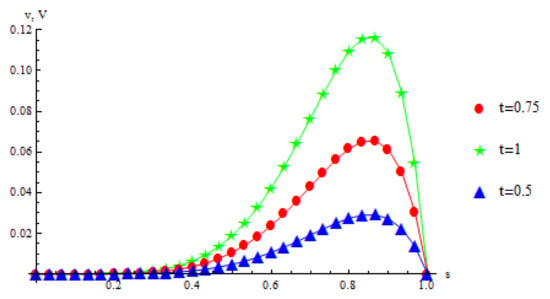
Figure 1.
The exact and approximate (triangles, stars, circles) solutions using cubic B-spline-based scheme for Example 1 at various times when .
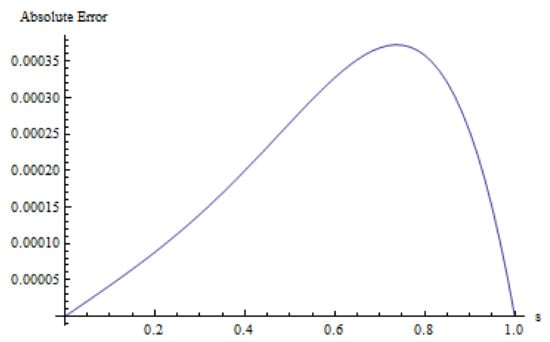
Figure 2.
The 2D error profile using cubic B-spline-based scheme for Example 1 when , , , .
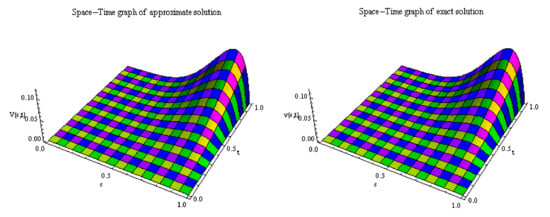
Figure 3.
The approximate (left) and exact (right) solutions using cubic B-spline-based scheme for Example 1 when , , , .
Example 2.
Consider the time fractional Cattaneo equation,
with ICs,
and BCs,
The corresponding source term is The analytic solution of the given problem is . In order to achieve the desired numerical results the presented schemes are applied on Example 2. The errors obtained by the schemes are compared with each other in Table 4, Table 5 and Table 6. For various time stages, a sharp contrast between the exact and approximate solutions is presented in Figure 4. The 2D absolute error profile is plotted in Figure 5. Figure 6 depicts a 3D comparison between the exact and approximate solutions.

Table 4.
Comparison of errors using various B-splines with for Example 2.

Table 5.
Comparison of errors using various B-splines with for Example 2.

Table 6.
Comparison of errors using various B-splines with for Example 2.
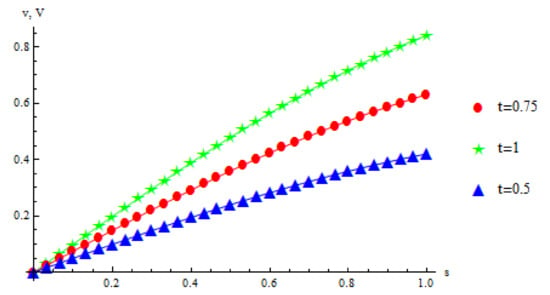
Figure 4.
The exact and approximate (triangles, stars, circles) solutions using cubic B-spline-based scheme for Example 2 at various times when .
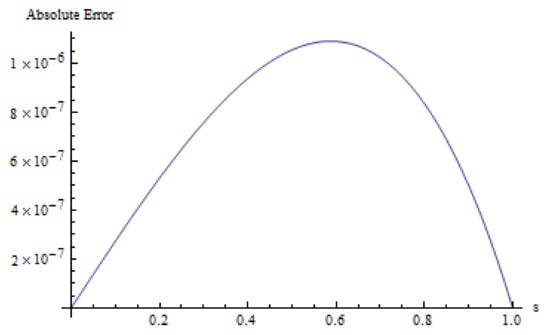
Figure 5.
The 2D error profile using cubic B-spline-based scheme for Example 2 when , , , .
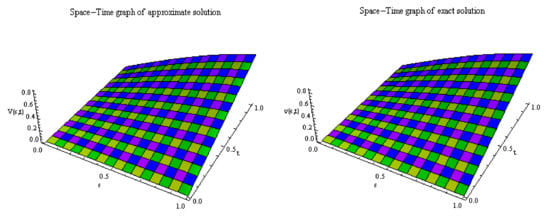
Figure 6.
The approximate (left) and exact (right) solutions using cubic B-spline-based scheme for Example 2 when , , , .
The approximate solution using cubic B-spline-based scheme when and at and for Example 2 are given by
and
respectively.
Example 3.
Consider the time fractional Cattaneo equation,
with ICs,
and BCs
The corresponding source term is The analytic solution of the given problem is . The proposed methodologies are utilized to acquire the numerical results for Example 3.
A comparison of computed errors is provided in Table 7, Table 8 and Table 9. For various time stages, a close comparison between the exact and approximate solutions is displayed in Figure 7. The 2D error function is plotted in Figure 8. Figure 9 depicts a 3D comparison between the exact and approximate solutions.

Table 7.
Comparison of errors using various B-splines with for Example 3.

Table 8.
Comparison of errors using various B-splines with for Example 3.

Table 9.
Comparison of errors using various B-splines with for Example 3.

Figure 7.
The exact and approximate (triangles, stars, circles) solutions using cubic B-spline-based scheme for Example 3 at various times when .
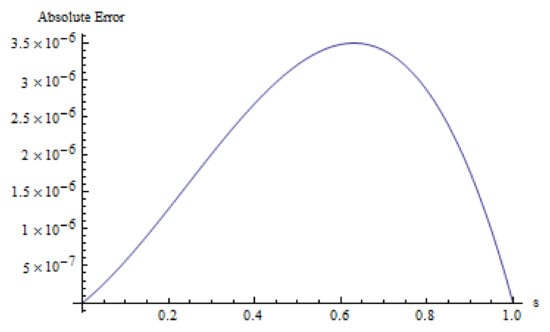
Figure 8.
The 2D error profile using cubic B-spline-based scheme when for Example 2 when , , , .
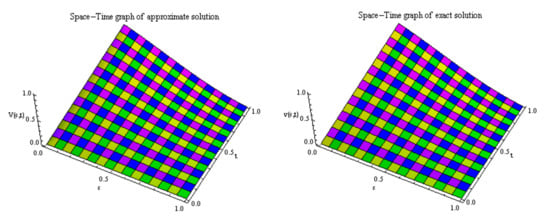
Figure 9.
The approximate (left) and exact (right) solutions using cubic B-spline-based scheme for Example 3 when , , , .
The approximate solution using cubic B-spline-based scheme when and at and for Example 3 are given by
and
respectively.
5. Concluding Remarks
The spline-based collocation schemes are developed for the numerical solution of the time fractional Cattaneo differential equation involving the Caputo–Fabrizio time fractional derivative. To begin with, the space derivative involved is approximated using the cubic B-spline. Secondly, using finite differences, the Caputo–Fabrizio derivative is approximated. The stability and convergence analysis of the schemes are also discussed in detail. The splines used are the cubic B-splines, extended cubic B-splines and the trigonometric cubic B-splines. The key advantage is that the approximate solution is obtained as a piecewise continuous function so that approximate solution at any desired position in the domain can be tracked. The efficiency and accuracy of the proposed approaches are confirmed by the experimental findings. The suggested schemes can be applied to a wide range of problems in varied fields of applied sciences.
Author Contributions
Conceptualization, M.Y., Q.U.N.A. and S.K.; methodology, Q.U.N.A. and R.G.; validation, R.G. and S.K.; formal analysis, M.Y., Q.U.N.A. and S.K.; investigation, S.K; writing—original draft preparation, Q.U.N.A.; writing—review and editing, M.Y., R.G. and S.K.; supervision, R.G. and M.Y.; project administration, R.G.; funding acquisition, R.G. All authors have read and agreed to the published version of the manuscript.
Funding
This research is supported by Deanship of Scientific Research, Prince Sattam bin Abdulaziz University, Alkharj, Saudi Arabia.
Institutional Review Board Statement
Not applicable.
Informed Consent Statement
Not applicable.
Data Availability Statement
No data were used.
Conflicts of Interest
The authors declare no conflict of interest.
References
- Liu, Z.; Cheng, A.; Li, X. A second order crank-Nicolson scheme for fractional Cattaneo equation based on new fractional derivative. Appl. Math. Comput. 2017, 311, 361–374. [Google Scholar] [CrossRef]
- Zheng, B. (G′/G)-expansion method for solving fractional partial differential equations in the theory of mathematical physics. Commun. Theor. Phys. 2012, 58, 623–630. [Google Scholar] [CrossRef]
- Tavares, D.; Almeida, R.; Torres, D.F.M. Caputo derivatives of fractional variable order: Numerical approximations. Commun. Nonlinear Sci. Numer. Simul. 2016, 35, 69–87. [Google Scholar] [CrossRef] [Green Version]
- Baleanu, D.; Rezapour, S.; Mohammadi, H. Some existence results on nonlinear fractional differential equations. Philos. Trans. R. Soc. A Math. Phys. Eng. Sci. 2013, 371, 20120144. [Google Scholar] [CrossRef] [PubMed]
- Diethelm, K.; Ford, N.J.; Freed, A.D. A predictor-corrector approach for the numerical solution of fractional differential equations. Nonlinear Dyn. 2002, 29, 3–22. [Google Scholar] [CrossRef]
- Meerschaert, M.M.; Tadjeran, C. Finite difference approximations for fractional advection–dispersion flow equations. J. Comput. Appl. Math. 2004, 172, 65–77. [Google Scholar] [CrossRef] [Green Version]
- Hashim, I.; Abdulaziz, O.; Momani, S. Homotopy analysis method for fractional IVPS. Commun. Nonlinear Sci. Numer. Simul. 2009, 14, 674–684. [Google Scholar] [CrossRef]
- Suarez, L.; Shokooh, A. An eigenvector expansion method for the solution of motion containing fractional derivatives. J. Appl. Mech. 1997, 64, 629–635. [Google Scholar] [CrossRef]
- Jafari, H.; Yousefi, S.; Firoozjaee, M.; Momani, S.; Khalique, C.M. Application of Legendre wavelets for solving fractional differential equations. Comput. Math. Appl. 2011, 62, 1038–1045. [Google Scholar] [CrossRef] [Green Version]
- Li, Y.; Zhao, W. Haar wavelet operational matrix of fractional order integration and its applications in solving the fractional order differential equations. Appl. Math. Comput. 2010, 216, 2276–2285. [Google Scholar] [CrossRef]
- Yuanlu, L. Solving a nonlinear fractional differential equation using Chebyshev wavelets. Commun. Nonlinear Sci. Numer. Simul. 2010, 15, 2284–2292. [Google Scholar]
- Li, Y.; Sun, N. Numerical solution of fractional differential equations using the generalized block pulse operational matrix. Comput. Math. Appl. 2011, 62, 1046–1054. [Google Scholar] [CrossRef] [Green Version]
- Odibat, Z. On Legendre polynomial approximation with the vim or ham for numerical treatment of nonlinear fractional differential eqations. J. Comput. Appl. Math. 2011, 235, 2956–2968. [Google Scholar] [CrossRef]
- Araci, S. Novel identities for q-Genocchi numbers and polynomials. J. Funct. Spaces Appl. 2012, 2012, 214961. [Google Scholar] [CrossRef] [Green Version]
- Gürbüz, B.; Sezer, M. Laguerre polynomial solutions of a class of initial and boundary value problems arising in science and engineering fields. Acta Phys. Pol. A 2016, 130, 194–197. [Google Scholar] [CrossRef]
- Caputo, M.; Fabrizio, M. A new definition of fractional derivative without singular kernel. Prog. Fract. Differ. Appl. 2015, 1, 73–85. [Google Scholar]
- Caputo, M.; Fabrizio, M. Applications of new time and spatial fractional derivatives with exponential kernels. Prog. Fract. Differ. Appl. 2016, 2, 1–11. [Google Scholar] [CrossRef]
- Feulefack, P.A.; Djida, J.D.; Abdon, A. A new model of groundwater flow within an unconfined aquifer: Application of Caputo-Fabrizio fractional derivative. Discret. Cont. Dyn. Syst.-B 2019, 24, 3227–3247. [Google Scholar] [CrossRef] [Green Version]
- Delgado, V.F.M.; Aguilar, J.F.G.; Saad, K.; Jiménez, R.F.E. Application of the Caputo-Fabrizio and Atangana-Baleanu fractional derivatives to mathematical model of cancer chemotherapy effect. Math. Methods Appl. Sci. 2019, 42, 1167–1193. [Google Scholar] [CrossRef]
- Abdon, A. On the new fractional derivative and application to nonlinear fishers reaction-diffusion equation. Appl. Math. Comput. 2016, 273, 948–956. [Google Scholar]
- Liu, Z.; Cheng, A.; Li, X. A fully discrete spectral method for fractional Cattaneo equation based on Caputo-Fabrizo derivative. Numer. Methods Partial Differ. Equ. 2019, 35, 936–954. [Google Scholar] [CrossRef]
- Compte, A.; Metzler, R. The generalized Cattaneo equation for the description of anomalous transport processes. J. Phys. A 1997, 30, 72–77. [Google Scholar] [CrossRef]
- Giusti, A. Why fractional derivatives with nonsingular kernels should not be used. Nonlinear Dyn. 2018, 93, 1757–1763. [Google Scholar] [CrossRef] [Green Version]
- Li, X.; Rui, H.; Liu, Z. A block-centered finite difference method for fractional Cattaneo equaton. Numer. Methods Partial Differ. Equ. 2018, 34, 296–316. [Google Scholar] [CrossRef] [Green Version]
- Dhiman, N.; Huntul, M.J.; Tamsir, M. A modified trigonometric cubic B-spline collocation technique for solving the time-fractional diffusion equation. Eng. Comput. 2021, 38. [Google Scholar] [CrossRef]
- Tamsir, M.; Dhiman, N.; Gill, F.C. Approximation of 3D convection diffusion equation using DQM based on modified cubic trigonometric B-splines. J. Comput. Methods Sci. Eng. 2020, 20, 1357–1366. [Google Scholar]
- Tamsir, M.; Dhiman, N. DQM Based on the Modified Form of CTB Shape Functions for Coupled Burgers’ Equation in 2D and 3D. Int. J. Math. Eng. Manag. Sci. 2019, 4, 1051–1067. [Google Scholar]
- Dhiman, N.; Tamsir, M. A collocation technique based on modified form of trigonometric cubic B-spline basis functions for Fisher’s reaction-diffusion equation. Multidiscip. Model. Mater. Struct. 2018, 14, 923–939. [Google Scholar] [CrossRef]
- Tamsir, M. Cubic trigonometric B-spline differential quadrature method for numerical treatment of Fisher’s reaction-diffusion equations. Alex. Eng. J. 2018, 53, 2019–2026. [Google Scholar]
- Abbas, M.; Majid, A.A.; Ismail, A.I.M.; Rashid, A. Numerical method using cubic b-spline for a strongly coupled reaction-diffusion system. PLoS ONE 2014, 9, e83265. [Google Scholar]
- Abbas, M.; Majid, A.A.; Ismail, A.I.M.; Rashid, A. The application of cubic trigonometric B-spline to the numerical solution of the hyperbolic problems. Appl. Math. Comput. 2014, 239, 74–88. [Google Scholar] [CrossRef]
- Morton, K.W.; Mayers, D.F. Numerical Solution of Partial Differential Equations: An Introduction; Cambridge University Press: Cambridge, UK, 2005. [Google Scholar]
- Smith, G.D. Numerical Solution of Partial Differential Equations: Finite Difference Methods; Oxford University Press: Oxford, UK, 1987. [Google Scholar]
Publisher’s Note: MDPI stays neutral with regard to jurisdictional claims in published maps and institutional affiliations. |
© 2022 by the authors. Licensee MDPI, Basel, Switzerland. This article is an open access article distributed under the terms and conditions of the Creative Commons Attribution (CC BY) license (https://creativecommons.org/licenses/by/4.0/).